Breaking through Barriers: A Systematic Review of Extended Reality in Education for the Visually Impaired
Abstract
1. Introduction
2. Methodology
2.1. Method
2.2. Research Aim and Questions
2.3. Data Sources and Search Strategies
2.4. Screening and Inter-Rater Reliability
2.5. Study Quality Assessment and Bias Mitigation Criteria
2.6. Data Extraction and Analysis
3. Findings and Discussion
3.1. Overview of Included Research Papers
3.2. RQ01: What Are the Prevalent Trends and Themes Surrounding the Use of XR in the Education of Individuals Who Are Blind or Have Visual Impairments?
3.2.1. Exploring the Potential of XR as an Educational Assistive Technology and in Inclusive Education
3.2.2. XR in Orientation and Mobility Education (O&M)
3.2.3. Spatial Cognition
3.2.4. Educational Games and Gamification
3.2.5. Multisensory Realities and Sensory Substitution
3.2.6. Authoring Tools for Educational Purposes
3.2.7. Academic Discipline
3.2.8. Educational Maps
3.2.9. Spatialized Audio
3.2.10. Multi-User Extended Realities and Group Work
3.2.11. Design Guidelines
3.3. What Challenges and Limitations Exist in Implementing XR in the Education of Individuals Who Are Blind or Have Visual Impairments?
3.4. RQ03: What Recommendations Can Be Made for Future Research on the Use of XR in the Education of Individuals Who Are Blind or Have Visual Impairments?
4. Conclusions
5. Limitations and Future Research
Author Contributions
Funding
Institutional Review Board Statement
Informed Consent Statement
Data Availability Statement
Conflicts of Interest
Appendix A
| Database | Keywords | Rules |
|---|---|---|
| Scopus | TITLE-ABS-KEY ((“Virtual Reality” OR “Augmented reality” OR “ Mixed realities “ OR “Mixed reality” OR “Extended Reality”) AND (“Visually Impaired” OR “Blind” OR “low vision”) AND (“education” OR “education*” OR “school”)) AND PUBYEAR > 2012 | Years = 2013–2023 Articles + Conference papers + Reviews English Only |
| TITLE-ABS-KEY (“audio-games” OR “audio games” OR “tactile games” OR “tactile-games”) | ||
| Science Direct | ((“Virtual Reality” OR “Augmented reality” OR “Mixed Reality” OR “Extended Reality”) AND (“Visually Impaired” OR “Blind” OR “low vision”) AND (“education” OR “school”)) | Years = 2013–2023 Articles + Conference papers + Reviews English Only |
| “audio-games” OR “audio games” OR “tactile games” OR “tactile-games” | ||
| ERIC | abstract: OR title: (“Virtual Reality” OR “Augmented reality” OR “ Mixed realities “ OR “Mixed reality” OR “Extended Reality”) AND (“Visually Impaired” OR “Blind” OR “low vision”) | Years = 2013–2023 Articles + Conference papers + Reviews English Only |
| “audio-games” OR “audio games” OR “tactile games” OR “tactile-games” | ||
| JSTOR | (“Virtual Reality” OR “Augmented reality” OR “Mixed Reality” OR “Extended Reality”) AND (“Visually Impaired” OR “Blind” OR “low vision”) AND (“education” OR “school”)) | Years = 2013–2023 Articles + Conference papers + Reviews English Only |
| “audio-games” OR “audio games” OR “tactile games” OR “tactile-games” | ||
| Taylor and Francic online | [[Abstract: “virtual reality”] OR [Abstract: “augmented reality”] OR [Abstract: “mixed reality”] OR [Abstract: “extended reality”]] AND [[Abstract: “visually impaired”] OR [Abstract: “blind”] OR [Abstract: “low vision”]] AND [[Abstract: “education”] OR [Abstract: “school”]] AND [Publication Date: (01/01/2013 TO 12/31/2023)] | Years = 2013–2023 Articles + Conference papers + Reviews English Only |
| [All: “audio-games”] OR [All: “audio games”] OR [All: “tactile games”] OR [All: “tactile-games”] AND [Publication Date: (01/01/2013 TO 12/31/2023)] |
Appendix B
| Item | Assessment Criteria | Description of Checklist |
|---|---|---|
| 1 | Does the article evidently define the study’s aim? |
|
| 2 | Are the research questions and/or objectives clearly defined? |
|
| 3 | The paper effectively presents a clear research method that is clear and replicable. |
|
| 4 | The presentation of the results is clear and unambiguous. |
|
| 5 | The study shares clear and relevant conclusions. |
|
References
- Hamash, M.; Mohamed, H. BASAER Team: The First Arabic Robot Team for Building the Capacities of Visually Impaired Students to Build and Program Robots. Int. J. Emerg. Technol. Learn. 2021, 16, 91–107. [Google Scholar] [CrossRef]
- Manar, M.; Rochyadi, E.; Sunardi, M. A Case Study of Students with Visual Disabilities in Inclusive Higher Education. In Proceedings of the 2nd INDOEDUC4ALL—Indonesian Education for All (INDOEDUC 2018), Banjarmasin, Indonesia, 18 October 2018; Atlantis Press: Banjarmasin, Indonesia, 2018. [Google Scholar] [CrossRef]
- Ludíková, L.; Finková, D. Improvement in Education of People with Visual Impairment. Procedia Soc. Behav. Sci. 2012, 55, 971–979. [Google Scholar] [CrossRef][Green Version]
- Wu, H.-K.; Lee, S.W.-Y.; Chang, H.-Y.; Liang, J.-C. Current Status, Opportunities and Challenges of Augmented Reality in Education. Comput. Educ. 2013, 62, 41–49. [Google Scholar] [CrossRef]
- De Souza Veriscimo, E.; Bernardes, J.L. 3D Interaction Accessible to Visually Impaired Users: A Systematic Review. In Universal Access in Human-Computer Interaction. Interaction Techniques and Environments; Antona, M., Stephanidis, C., Eds.; Lecture Notes in Computer Science; Springer International Publishing: Cham, Switzerland, 2016; Volume 9738, pp. 251–260. [Google Scholar] [CrossRef]
- Gough, D.; Thomas, J.; Oliver, S. Clarifying Differences between Review Designs and Methods. Syst. Rev. 2012, 1, 28. [Google Scholar] [CrossRef] [PubMed]
- Page, M.J.; Moher, D.; Bossuyt, P.M.; Boutron, I.; Hoffmann, T.C.; Mulrow, C.D.; Shamseer, L.; Tetzlaff, J.M.; Akl, E.A.; Brennan, S.E.; et al. PRISMA 2020 Explanation and Elaboration: Updated Guidance and Exemplars for Reporting Systematic Reviews. BMJ 2021, 372, n160. [Google Scholar] [CrossRef] [PubMed]
- Cohen, J. A Coefficient of Agreement for Nominal Scales. Educ. Psychol. Meas. 1960, 20, 37–46. [Google Scholar] [CrossRef]
- Fleiss, J.L.; Levin, B.; Paik, M.C. Statistical Methods for Rates and Proportions, 1st ed.; Wiley Series in Probability and Statistics; Wiley: Hoboken, NJ, USA, 2003. [Google Scholar] [CrossRef]
- Mystakidis, S.; Christopoulos, A.; Pellas, N. A Systematic Mapping Review of Augmented Reality Applications to Support STEM Learning in Higher Education. Educ. Inf. Technol. 2022, 27, 1883–1927. [Google Scholar] [CrossRef]
- Sanusi, I.T.; Oyelere, S.S.; Vartiainen, H.; Suhonen, J.; Tukiainen, M. A Systematic Review of Teaching and Learning Machine Learning in K-12 Education. Educ. Inf. Technol. 2023, 28, 5967–5997. [Google Scholar] [CrossRef]
- Deng, X.; Yu, Z. A Systematic Review of Machine-Translation-Assisted Language Learning for Sustainable Education. Sustainability 2022, 14, 7598. [Google Scholar] [CrossRef]
- Moule, P.; Pontin, D.; Gilchrist, M.; Ingram, R. Critical Appraisal Framework. 2003. Available online: http://hsc.uwe.ac.uk/dataanalysis/critFrame.asp© (accessed on 15 February 2024).
- Kitchenham, B.; Pearl Brereton, O.; Budgen, D.; Turner, M.; Bailey, J.; Linkman, S. Systematic Literature Reviews in Software Engineering—A Systematic Literature Review. Inf. Softw. Technol. 2009, 51, 7–15. [Google Scholar] [CrossRef]
- Braun, V.; Clarke, V. Thematic Analysis: A Practical Guide; SAGE: London, UK, 2022. [Google Scholar]
- Ponce Gallegos, J.C.; Montes Rivera, M.; Ornelas Zapata, F.J.; Padilla Díaz, A. Augmented Reality as a Tool to Support the Inclusion of Colorblind People. In HCI International 2020—Late Breaking Papers: Universal Access and Inclusive Design; Stephanidis, C., Antona, M., Gao, Q., Zhou, J., Eds.; Lecture Notes in Computer Science; Springer International Publishing: Cham, Switzerland, 2020; Volume 12426, pp. 306–317. [Google Scholar] [CrossRef]
- Nishikiri, M.; Sakai, T.; Kudo, H.; Matsumoto, T.; Takeuchi, Y.; Ohnishi, N. System Supporting Independent Walking of the Visually Impaired. In Computers Helping People with Special Needs; Miesenberger, K., Bühler, C., Penaz, P., Eds.; Lecture Notes in Computer Science; Springer International Publishing: Cham, Switzerland, 2016; Volume 9759, pp. 186–189. [Google Scholar] [CrossRef]
- Audomphon, A.; Apavatjrut, A. Smart Glasses for Sign Reading as Mobility Aids for the Blind Using a Light Communication System. In Proceedings of the 2020 17th International Conference on Electrical Engineering/Electronics, Computer, Telecommunications and Information Technology (ECTI-CON), Phuket, Thailand, 24–27 June 2020; IEEE: Phuket, Thailand, 2020; pp. 615–618. [Google Scholar] [CrossRef]
- Riethus, A. An Inclusive Prehistory Game by the Blind and Visually Impaired. Creating an Inclusive App Game on Prehistoric Archaeology with the BSVN e.V. for the Permanent Exhibition of the Neanderthal Museum. Communicating the Past in the Digital Age. In Proceedings of the International Conference on Digital Methods in Teaching and Learning in Archaeology, Cologne, Germany, 12–13 October 2018. [Google Scholar] [CrossRef]
- Onishi, J.; Sakai, T.; Sakajiri, M.; Ogata, A.; Miura, T.; Handa, T.; Hiruma, N.; Shimizu, T.; Ono, T. Experimenting with Tactile Sense and Kinesthetic Sense Assisting System for Blind Education. In Computers Helping People with Special Needs; Miesenberger, K., Bühler, C., Penaz, P., Eds.; Lecture Notes in Computer Science; Springer International Publishing: Cham, Switzerland, 2016; Volume 9759, pp. 92–99. [Google Scholar] [CrossRef]
- Tao, Y.; Ding, L.; Wang, S.; Ganz, A. PERCEPT Indoor Wayfinding for Blind and Visually Impaired Users: Navigation Instructions Algorithm and Validation Framework. In Proceedings of the 3rd International Conference on Information and Communication Technologies for Ageing Well and e-Health, Porto, Portugal, 28–29 April 2017; SCITEPRESS—Science and Technology Publications: Porto, Portugal, 2017; pp. 143–149. [Google Scholar] [CrossRef]
- Jeffs, T.L. Virtual Reality and Special Needs. Themes Sci. Technol. Educ. 2014, 2, 253–268. [Google Scholar]
- Silva De Souza, E.; Cardoso, A.; Lamounier, E. A Virtual Environment-Based Training System for a Blind Wheelchair User Through Use of Three-Dimensional Audio Supported by Electroencephalography. Telemed. e-Health 2018, 24, 614–620. [Google Scholar] [CrossRef]
- Manouchou, E.; Stavroulia, K.-E.; Ruiz-Harisiou, A.; Georgiou, K.; Sella, F.; Lanitis, A. A Feasibility Study on Using Virtual Reality for Understanding Deficiencies of High School Students. In Proceedings of the 2016 18th Mediterranean Electrotechnical Conference (MELECON), Lemesos, Cyprus, 18–20 April 2016; IEEE: Lemesos, Cyprus, 2016; pp. 1–6. [Google Scholar] [CrossRef]
- Dragos Bogdan Moldoveanu, A.; Stanica, I.; Dascalu, M.-I.; Nicoleta Bodea, C.; Flamaropol, D.; Moldoveanu, F.; Taloi, B.; Unntorsson, R. Virtual Environments for Training Visually Impaired for a Sensory Substitution Device. In Proceedings of the 2017 Zooming Innovation in Consumer Electronics International Conference (ZINC), Novi Sad, Serbia, 31 May–1 June 2017; IEEE: Novi Sad, Serbia, 2017; pp. 26–29. [Google Scholar] [CrossRef]
- Espinosa-Castaneda, R.; Medellin-Castillo, H.I. Virtual Haptic Perception as an Educational Assistive Technology: A Case Study in Inclusive Education. IEEE Trans. Haptics 2021, 14, 152–160. [Google Scholar] [CrossRef]
- Cavaco, S.; Simões, D.; Silva, T. Spatialized Audio in a Vision Rehabilitation Game for Training Orientation and Mobility Skills. In Proceedings of the 18th International Conference on Digital Audio Effects, Trondheim, Norway, 30 November–3 December 2015. [Google Scholar]
- Ricci, F.S.; Boldini, A.; Beheshti, M.; Rizzo, J.-R.; Porfiri, M. A Virtual Reality Platform to Simulate Orientation and Mobility Training for the Visually Impaired. Virtual Real. 2023, 27, 797–814. [Google Scholar] [CrossRef]
- Maidenbaum, S.; Buchs, G.; Abboud, S.; Lavi-Rotbain, O.; Amedi, A. Perception of Graphical Virtual Environments by Blind Users via Sensory Substitution. PLoS ONE 2016, 11, e0147501. [Google Scholar] [CrossRef] [PubMed]
- Wei, L.; Jin, L.; Gong, R.; Yang, Y.; Zhang, X. Design of Audio-Augmented-Reality-Based O&M Orientation Training for Visually Impaired Children. Sensors 2022, 22, 9487. [Google Scholar] [CrossRef]
- Regal, G.; Mattheiss, E.; Sellitsch, D.; Tscheligi, M. Mobile Location-Based Games to Support Orientation & Mobility Training for Visually Impaired Students. In Proceedings of the 20th International Conference on Human-Computer Interaction with Mobile Devices and Services, Barcelona, Spain, 3–6 September 2018; ACM: Barcelona, Spain, 2018; pp. 1–12. [Google Scholar] [CrossRef]
- Ruvolo, P.; Louie, R.; Jerman, E. The Cane Game: An Educational Tool for Orientation and Mobility. In Extended Abstracts of the 2023 CHI Conference on Human Factors in Computing Systems; ACM: Hamburg, Germany, 2023; pp. 1–7. [Google Scholar] [CrossRef]
- Maidenbaum, S.; Levy-Tzedek, S.; Chebat, D.-R.; Amedi, A. Increasing Accessibility to the Blind of Virtual Environments, Using a Virtual Mobility Aid Based On the “EyeCane”: Feasibility Study. PLoS ONE 2013, 8, e72555. [Google Scholar] [CrossRef] [PubMed]
- Balan, O.; Moldoveanu, A.; Moldoveanu, F.; Dascalu, M.-I. Navigational 3D Audio-Based Game-Training towards Rich Auditory Spatial Representation of the Environment. In Proceedings of the 2014 18th International Conference on System Theory, Control and Computing (ICSTCC), Sinaia, Romania, 17–19 October 2014; IEEE: Sinaia, Romania, 2014; pp. 682–687. [Google Scholar] [CrossRef]
- Balan, O.; Moldoveanu, A.; Moldoveanu, F. Navigational Audio Games: An Effective Approach toward Improving Spatial Contextual Learning for Blind People. Int. J. Disabil. Hum. Dev. 2015, 14, 109–118. [Google Scholar] [CrossRef]
- Bălan, O.; Moldoveanu, A.; Moldoveanu, F.; Nagy, H.; Wersényi, G.; Unnórsson, R. Improving the Audio Game–Playing Performances of People with Visual Impairments through Multimodal Training. J. Vis. Impair. Blind. 2017, 111, 148–164. [Google Scholar] [CrossRef]
- Allain, K.; Dado, B.; Van Gelderen, M.; Hokke, O.; Oliveira, M.; Bidarra, R.; Gaubitch, N.D.; Hendriks, R.C.; Kybartas, B. An Audio Game for Training Navigation Skills of Blind Children. In Proceedings of the 2015 IEEE 2nd VR Workshop on Sonic Interactions for Virtual Environments (SIVE), Arles, France, 24 March 2015; IEEE: Arles, France, 2015; pp. 1–4. [Google Scholar] [CrossRef]
- Seki, Y. Wide-Range Auditory Orientation Training System for Blind O&M. In Universal Access in Human-Computer Interaction. Access to the Human Environment and Culture; Antona, M., Stephanidis, C., Eds.; Lecture Notes in Computer Science; Springer International Publishing: Cham, Switzerland, 2015; Volume 9178, pp. 150–159. [Google Scholar] [CrossRef]
- Merabet, L.B.; Sánchez, J. Development of an Audio-Haptic Virtual Interface for Navigation of Large-Scale Environments for People Who Are Blind. In Universal Access in Human-Computer Interaction. Users and Context Diversity; Antona, M., Stephanidis, C., Eds.; Lecture Notes in Computer Science; Springer International Publishing: Cham, Switzerland, 2016; Volume 9739, pp. 595–606. [Google Scholar] [CrossRef]
- Patel, K.K.; Kumar Vij, S. Unconstrained Walking Plane to Virtual Environment for Spatial Learning by Visually Impaired. In Assistive Technologies: Concepts, Methodologies, Tools, and Applications; IGI Global: Hershey, PA, USA, 2014; pp. 1580–1599. [Google Scholar] [CrossRef]
- Papadopoulos, K.; Charitakis, K.; Koustriava, E.; Kartasidou, L.; Stylianidis, E.; Kouroupetroglou, G.; Sakalli Gumus, S.; Müller, K.; Yilmaz, E. Specification of Symbols Used in Audio-Tactile Maps for Individuals with Blindness. In Computers Helping People with Special Needs; Miesenberger, K., Bühler, C., Penaz, P., Eds.; Lecture Notes in Computer Science; Springer International Publishing: Cham, Switzerland, 2016; Volume 9759, pp. 160–167. [Google Scholar] [CrossRef]
- Berretta, L.; Soares, F.; Ferreira, D.J.; Nascimento, H.A.D.; Cardoso, A.; Lamounier, E. Virtual Environment Manipulated by Recognition of Poses Using Kinect: A Study to Help Blind Locomotion in Unfamiliar Surroundings. In Proceedings of the 2013 XV Symposium on Virtual and Augmented Reality, Cuiaba, Brazil, 28–31 May 2013; IEEE: Cuiabá, Brazil, 2013; pp. 10–16. [Google Scholar] [CrossRef]
- Paredes, N.E.G.; Cobo, A.; Martín, C.; Serrano, J.J. Methodology for Building Virtual Reality Mobile Applications for Blind People on Advanced Visits to Unknown Interior Spaces. In Proceedings of the 14th International Conference Mobile Learning, Lisbon, Portugal, 14–16 April 2018. [Google Scholar]
- Ivascu, S.; Moldoveanu, F.; Moldoveanu, A.; Morar, A.; Tugulea, A.-M.; Asavei, V. Flying a Quadcopter—An Audio Entertainment and Training Game for the Visually Impaired. Appl. Sci. 2023, 13, 6769. [Google Scholar] [CrossRef]
- Tan, S.; Huang, W.; Shang, J. Research Status and Trends of the Gamification Design for Visually Impaired People in Virtual Reality. In HCI in Games; Fang, X., Ed.; Lecture Notes in Computer Science; Springer International Publishing: Cham, Switzerland, 2022; Volume 13334, pp. 637–651. [Google Scholar] [CrossRef]
- Jadán-Guerrero, J.; Arias-Flores, H.; Altamirano, I. Q’inqu: Inclusive Board Game for the Integration of People with Disabilities. In Applied Technologies; Botto-Tobar, M., Zambrano Vizuete, M., Torres-Carrión, P., Montes León, S., Pizarro Vásquez, G., Durakovic, B., Eds.; Communications in Computer and Information Science; Springer International Publishing: Cham, Switzerland, 2020; Volume 1193, pp. 85–94. [Google Scholar] [CrossRef]
- Paciulli, G.H.; De Lima, Y.C.; Faccin, M.T.; Amelia Eliseo, M. Accessible Augmented Reality to Support Chemistry Teaching. In 2020 XV Conferencia Latinoamericana de Tecnologias de Aprendizaje (LACLO); IEEE: Loja, Ecuador, 2020; pp. 1–9. [Google Scholar] [CrossRef]
- Rovithis, E.; Floros, A.; Moustakas, N.; Vogklis, K.; Kotsira, L. Bridging Audio and Augmented Reality towards a New Generation of Serious Audio-only Games. Electron. J. e-Learn. 2019, 17, 144–156. [Google Scholar] [CrossRef]
- Adkins, A.; Kohm, K.; Zhang, R.; Gustafson, N. Lost in Spaze: An Audio Maze Game for the Visually Impaired. In Extended Abstracts of the 2020 CHI Conference on Human Factors in Computing Systems; ACM: Honolulu, HI, USA, 2020; pp. 1–6. [Google Scholar] [CrossRef]
- Gong, J.; Shi, Y.; Wang, J.; Shi, D.; Xu, Y. Escape from the Dark Jungle: A 3D Audio Game for Emotion Regulation. In Virtual, Augmented and Mixed Reality: Applications in Health, Cultural Heritage, and Industry; Chen, J.Y.C., Fragomeni, G., Eds.; Lecture Notes in Computer Science; Springer International Publishing: Cham, Switzerland, 2018; Volume 10910, pp. 57–76. [Google Scholar] [CrossRef]
- Sekhavat, Y.A.; Azadehfar, M.R.; Zarei, H.; Roohi, S. Sonification and Interaction Design in Computer Games for Visually Impaired Individuals. Multimed. Tools Appl. 2022, 81, 7847–7871. [Google Scholar] [CrossRef]
- Tong, T.; Zingaro, D.; Engels, S. Design Guidelines for Audio-Based Game Features. In Proceedings of the First ACM SIGCHI Annual Symposium on Computer-Human Interaction in Play, Toronto, ON, Canada, 19–24 October 2014; ACM: Toronto, ON, Canada, 2014; pp. 443–444. [Google Scholar] [CrossRef]
- Spöhrer, M.; Dwivedi, A. (Eds.) Playing with Auditory Environments in Audio Games: Snake 3D. In Analytical Frameworks, Applications, and Impacts of ICT and Actor-Network Theory; Advances in Human and Social Aspects of Technology; IGI Global: Hershey, PA, USA, 2019. [Google Scholar] [CrossRef]
- Baas, B.; Van Peer, D.; Gerling, J.; Tavasszy, M.; Buskulic, N.; Salamon, N.Z.; Balint, J.T.; Bidarra, R. Loud and Clear: The VR Game without Visuals. In Games and Learning Alliance; Liapis, A., Yannakakis, G.N., Gentile, M., Ninaus, M., Eds.; Lecture Notes in Computer Science; Springer International Publishing: Cham, Switzerland, 2019; Volume 11899, pp. 180–190. [Google Scholar] [CrossRef]
- Chavez Sanchez, F.; Angelica Martinez De La Peña, G.; Adriana Mendoza Franco, G.; Iroel Heredia Carrillo, E. Exploring Audio Game Design with Visually Impaired Players: A Mexican Case Study. In Audio Mostly 2021; ACM: Trento, Italy, 2021; pp. 24–31. [Google Scholar] [CrossRef]
- Asakawa, N.; Wada, H.; Shimomura, Y.; Takasugi, K. Development of VR Tactile Educational Tool for Visually Impaired Children: Adaptation of Optical Motion Capture as a Tracker. Sens. Mater. 2020, 32, 3617. [Google Scholar] [CrossRef]
- Albouys-Perrois, J.; Laviole, J.; Briant, C.; Brock, A.M. Towards a Multisensory Augmented Reality Map for Blind and Low Vision People: A Participatory Design Approach. In Proceedings of the 2018 CHI Conference on Human Factors in Computing Systems, Montreal, QC, Canada, 21–26 April 2018; ACM: Montreal, QC, Canada, 2018; pp. 1–14. [Google Scholar] [CrossRef]
- Thevin, L.; Brock, A.M. Augmented Reality for People with Visual Impairments: Designing and Creating Audio-Tactile Content from Existing Objects. In Computers Helping People with Special Needs; Miesenberger, K., Kouroupetroglou, G., Eds.; Lecture Notes in Computer Science; Springer International Publishing: Cham, Switzerland, 2018; Volume 10897, pp. 193–200. [Google Scholar] [CrossRef]
- Kastrup, V.; Cassinelli, A.; Quérette, P.; Bergstrom, N.; Sampaio, E. Tactile Radar: Experimenting a Computer Game with Visually Disabled. Disabil. Rehabil. Assist. Technol. 2018, 13, 777–784. [Google Scholar] [CrossRef] [PubMed]
- Lee, E.; Kamat, M.; Temor, L.; Schiafone, C.; Fan, L.; Liu, J.; Coppin, P.; Uribe-Quevedo, A.; Ingino, R.; Syed, A.R.; et al. Prototyping a Spatial Skills AR Authoring Tool for Partially Sighted, Blind, and Sighted Individuals. In Proceedings of the 2022 IEEE Games, Entertainment, Media Conference (GEM), St. Michael, Barbados, 27–30 November 2022; IEEE: St. Michael, Barbados, 2022; pp. 1–6. [Google Scholar] [CrossRef]
- Marichal, S.; Rosales, A.; Sansone, G.; Pires, A.C.; Bakala, E.; Perilli, F.G.; Fleischer, B.; Blat, J. LETSmath. In Proceedings of the 20th International Conference on Human-Computer Interaction with Mobile Devices and Services Adjunct, Barcelona, Spain, 3–6 September 2018; ACM: Barcelona, Spain, 2018; pp. 313–320. [Google Scholar] [CrossRef]
- Kobayashi, M.; Tatsumi, H. Floor-Volleyball Motion Feedback System for Visually Impaired Players. In Proceedings of the 2020 12th International Conference on Education Technology and Computers, London, UK, 23–26 October 2020; ACM: London, UK, 2020; pp. 46–50. [Google Scholar] [CrossRef]
- Pothumani, S.; Velvizhi, R.; Amudha, S. Learning through Virtual Environment. Int. J. Eng. Adv. Technol. 2019, 8, 232–235. [Google Scholar] [CrossRef]
- De Oliveira, P.A.; Lotto, E.P.; Correa, A.G.D.; Taboada, L.G.G.; Costa, L.C.P.; Lopes, R.D. Virtual Stage: An Immersive Musical Game for People with Visual Impairment. In Proceedings of the 2015 14th Brazilian Symposium on Computer Games and Digital Entertainment (SBGames), Piaui, Brazil, 11–13 November 2015; IEEE: Piaui, Brazil, 2015; pp. 135–141. [Google Scholar] [CrossRef]
- Rovithis, E.; Mniestris, A.; Floros, A. Educational Audio Game Design: Sonification of the Curriculum through a Role-Playing Scenario in the Audio Game “Kronos”. In Proceedings of the 9th Audio Mostly: A Conference on Interaction with Sound, Aalborg, Denmark, 1–3 October 2014; ACM: Aalborg Denmark, 2014; pp. 1–6. [Google Scholar] [CrossRef]
- Medellín-Castillo, H.I.; González-Badillo, G.; Govea, E.; Espinosa-Castañeda, R.; Gallegos, E. Development of Haptic-Enabled Virtual Reality Applications for Engineering, Medicine and Art. In Systems, Design, and Complexity; American Society of Mechanical Engineers: Houston, TX, USA, 2015; Volume 11, p. V011T14A006. [Google Scholar] [CrossRef]
- Miura, T.; Ando, G.; Onishi, J.; Matsuo, M.; Sakajiri, M.; Ono, T. Virtual Museum for People with Low Vision: Comparison of the Experience on Flat and Head-Mounted Displays. In Computers Helping People with Special Needs; Miesenberger, K., Kouroupetroglou, G., Eds.; Lecture Notes in Computer Science; Springer International Publishing: Cham, Switzerland, 2018; Volume 10897, pp. 246–249. [Google Scholar] [CrossRef]
- Laviole, J.; Thevin, L.; Albouys-Perrois, J.; Brock, A. Nectar: Multi-User Spatial Augmented Reality for Everyone: Three Live Demonstrations of Educative Applications. In Proceedings of the Virtual Reality International Conference—Laval Virtual, Laval, France, 4 April 2018; ACM: Laval, France, 2018; pp. 1–6. [Google Scholar] [CrossRef]
- Moll, J.; Pysander, E.-L.S. A Haptic Tool for Group Work on Geometrical Concepts Engaging Blind and Sighted Pupils. ACM Trans. Access. Comput. 2013, 4, 1–37. [Google Scholar] [CrossRef]
- Bauer, V.; Nagele, A.; Baume, C.; Cowlishaw, T.; Cooke, H.; Pike, C.; Healey, P.G.T. Designing an Interactive and Collaborative Experience in Audio Augmented Reality. In Virtual Reality and Augmented Reality; Bourdot, P., Interrante, V., Nedel, L., Magnenat-Thalmann, N., Zachmann, G., Eds.; Lecture Notes in Computer Science; Springer International Publishing: Cham, Switzerland, 2019; Volume 11883, pp. 305–311. [Google Scholar] [CrossRef]
- Yiannoutsou, N.; Johnson, R.; Price, S. Non Visual Virtual Reality. Educ. Technol. Soc. 2021, 24, 151–163. [Google Scholar]
- Urbanek, M.; Güldenpfennig, F. Tangible Audio Game Development Kit: Prototyping Audio Games with a Tangible Editor. In Proceedings of the Eleventh International Conference on Tangible, Embedded, and Embodied Interaction, Yokohama, Japan, 20–23 March 2017; ACM: Yokohama, Japan, 2017; pp. 473–479. [Google Scholar] [CrossRef]
- Pucher, M.; Zillinger, B.; Toman, M.; Schabus, D.; Valentini-Botinhao, C.; Yamagishi, J.; Schmid, E.; Woltron, T. Influence of Speaker Familiarity on Blind and Visually Impaired Children’s and Young Adults’ Perception of Synthetic Voices. Comput. Speech Lang. 2017, 46, 179–195. [Google Scholar] [CrossRef]
- Papadopoulos, K.; Charitakis, K.; Kartasidou, L.; Kouroupetroglou, G.; Sakalli Gumus, S.; Stylianidis, E.; Stiefelhagen, R.; Müller, K.; Yilmaz, E.; Jaworek, G.; et al. User Requirements Regarding Information Included in Audio-Tactile Maps for Individuals with Blindness. In Computers Helping People with Special Needs; Miesenberger, K., Bühler, C., Penaz, P., Eds.; Lecture Notes in Computer Science; Springer International Publishing: Cham, Switzerland, 2016; Volume 9759, pp. 168–175. [Google Scholar] [CrossRef]
- Herskovitz, J.; Wu, J.; White, S.; Pavel, A.; Reyes, G.; Guo, A.; Bigham, J.P. Making Mobile Augmented Reality Applications Accessible. In Proceedings of the 22nd International ACM SIGACCESS Conference on Computers and Accessibility, Virtual Event, Greece, 26–28 October 2020; pp. 1–14. [Google Scholar] [CrossRef]
- Baldan, S.; Götzen, A.D.; Serafin, S. Sonic Tennis: A Rhythmic Interaction Game for Mobile Devices. In Proceedings of the NIME, NIME’13, KAIST, Daejeon, Korea, 27 – 30 May 2013. [Google Scholar]
- Ichikari, R.; Yanagimachi, T.; Kurata, T. Augmented Reality Tactile Map with Hand Gesture Recognition. In Computers Helping People with Special Needs; Miesenberger, K., Bühler, C., Penaz, P., Eds.; Lecture Notes in Computer Science; Springer International Publishing: Cham, Switzerland, 2016; Volume 9759, pp. 123–130. [Google Scholar] [CrossRef]
- Dam, A.; Siddiqui, A.; Leclercq, C.; Jeon, M. Taxonomy and Definition of Audio Augmented Reality (AAR): A Grounded Theory Study. Int. J. Hum. Comput. Stud. 2024, 182, 103179. [Google Scholar] [CrossRef]
- Rovithis, E.; Floros, A.; Kotsira, L. Educational Audio Gamification: Theory and Practice. In European Conference on e-Learning; Academic Conferences International Limited: Manchester, UK, 2018; pp. 497–505. [Google Scholar]
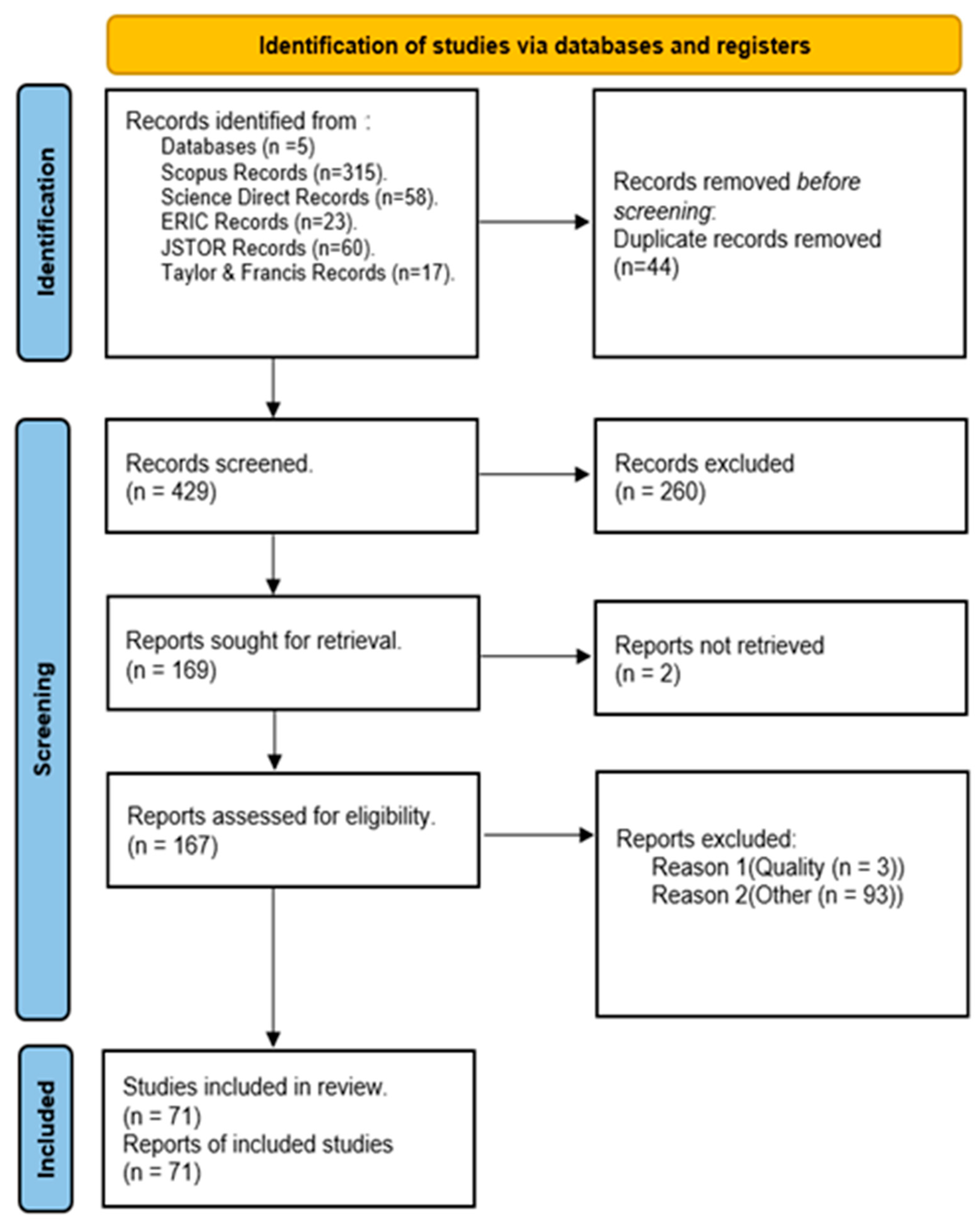
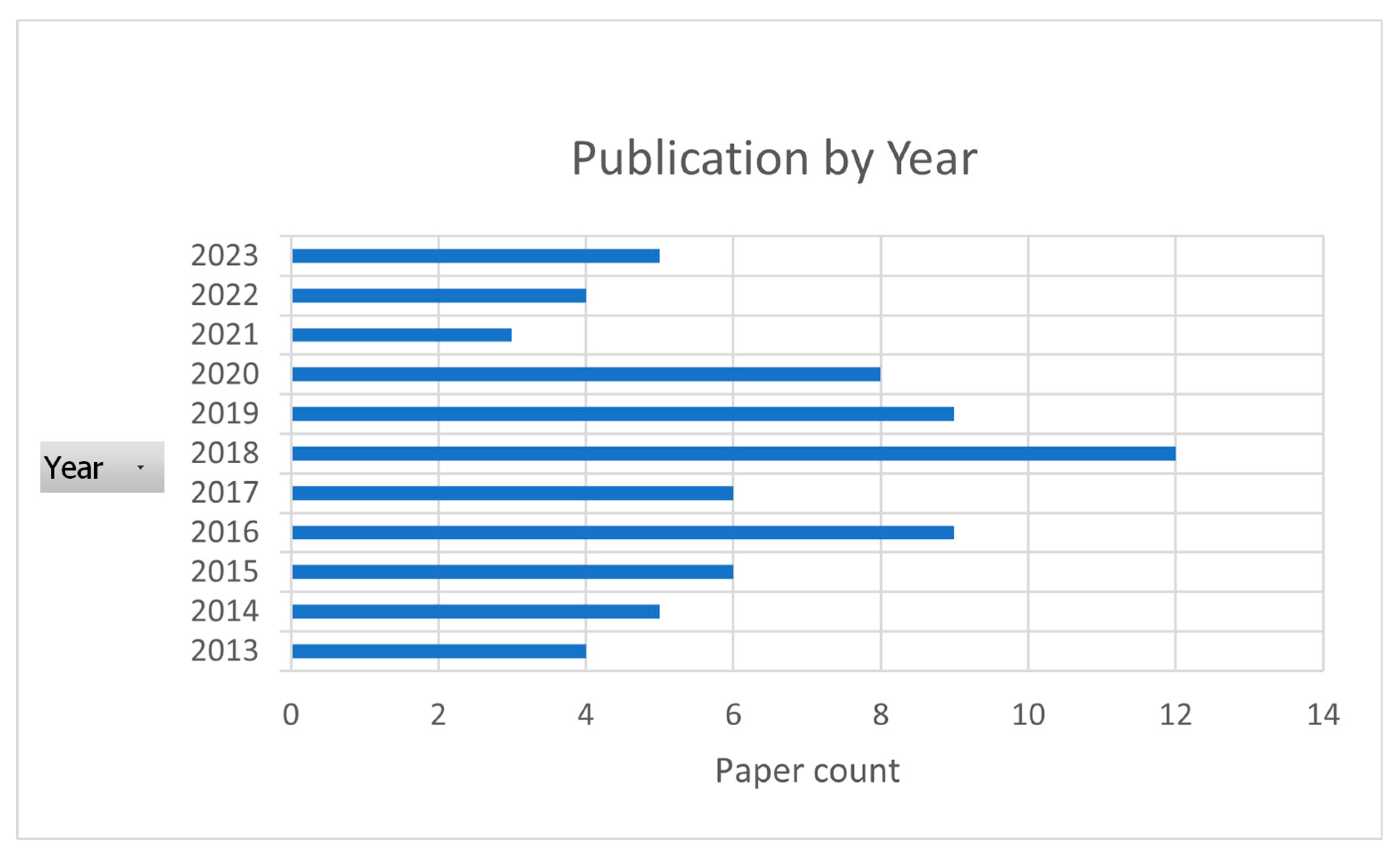
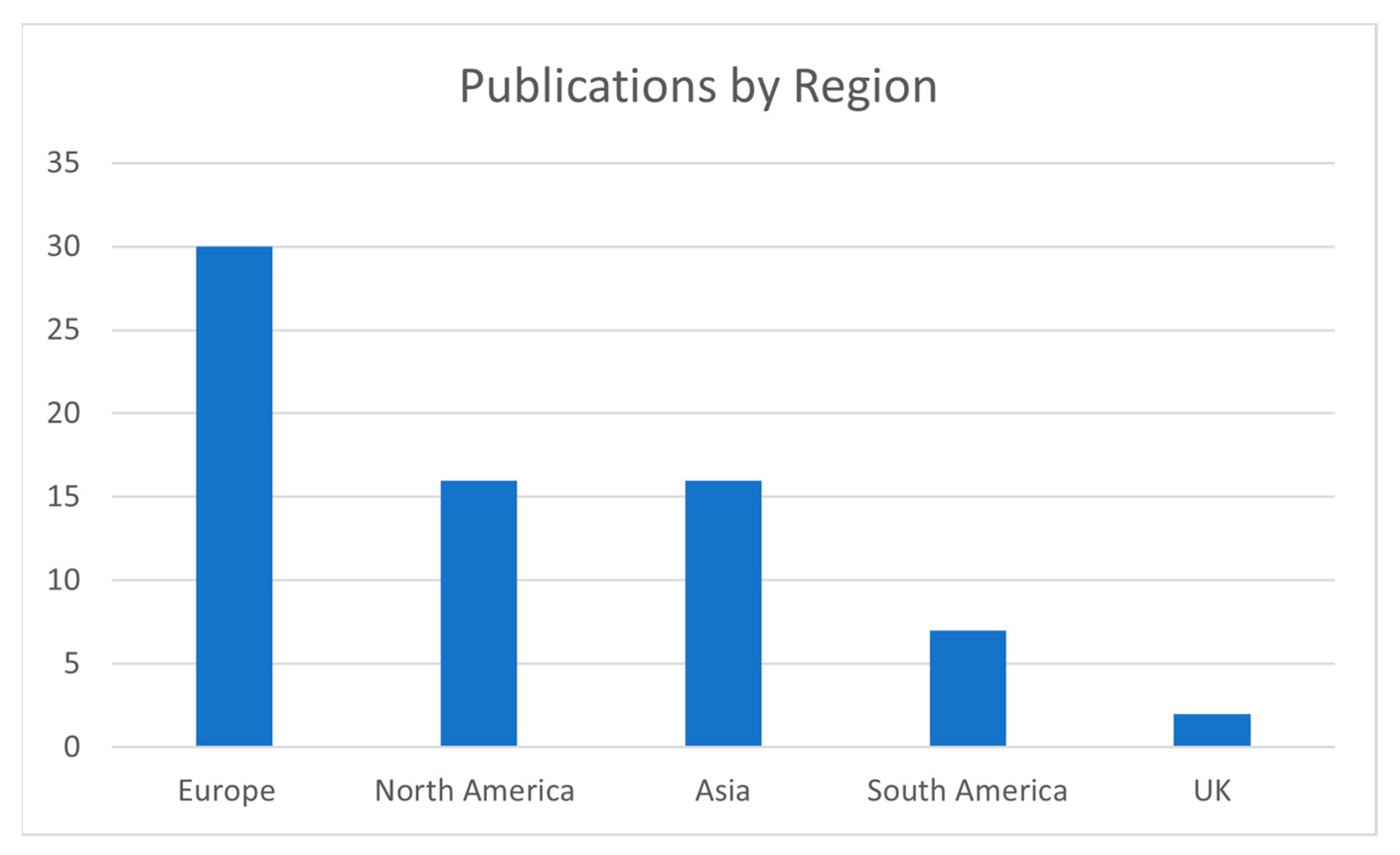
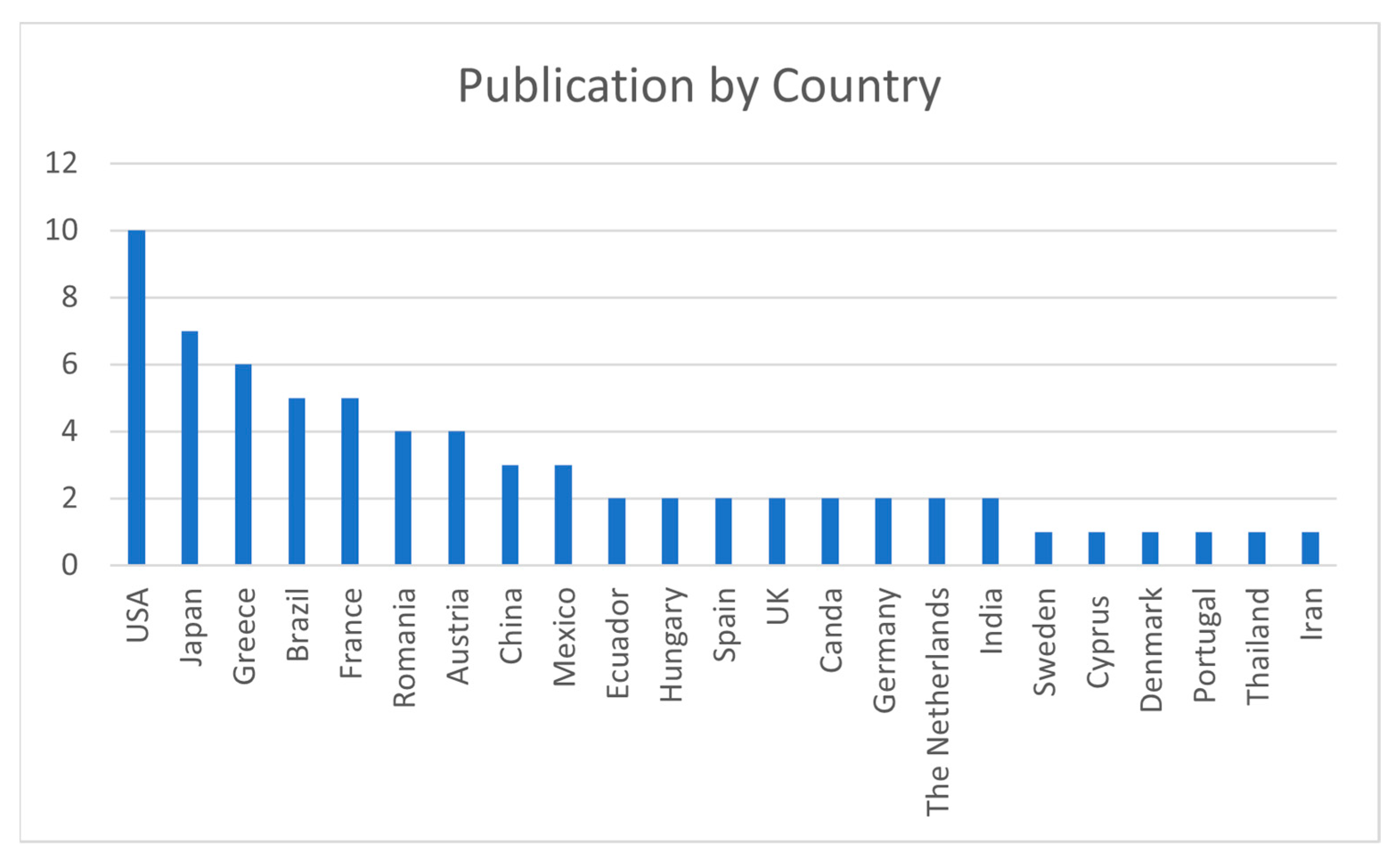
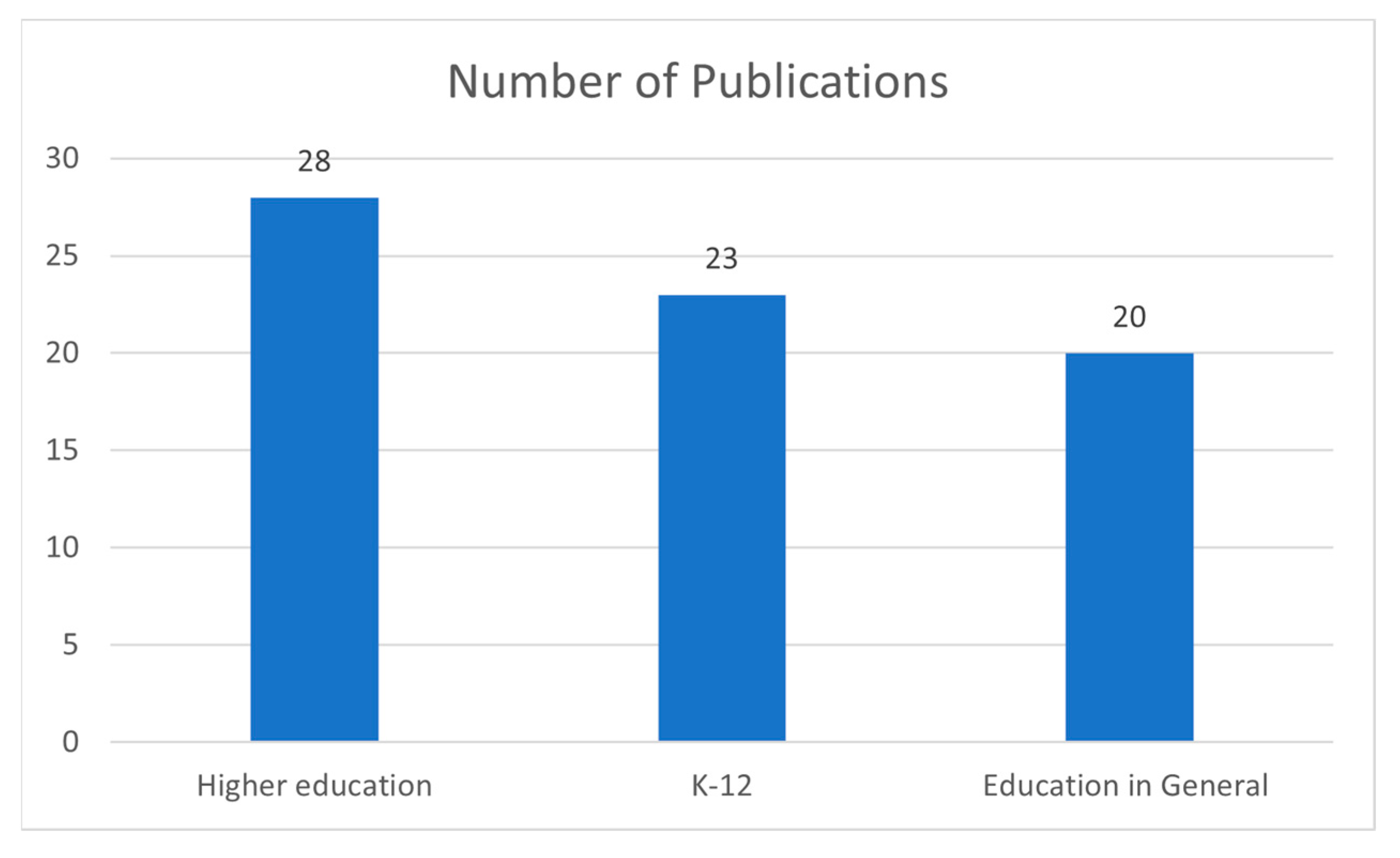
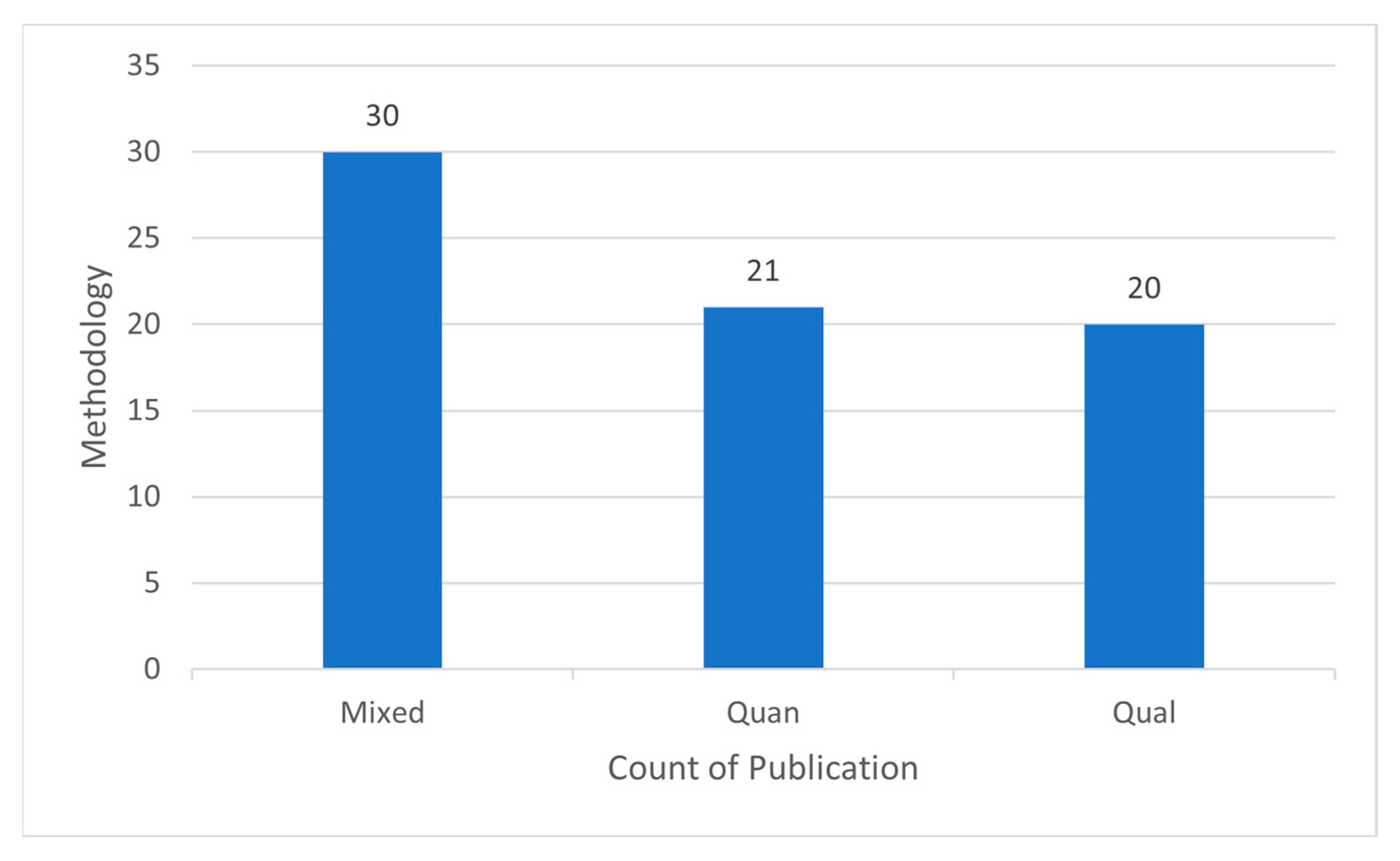
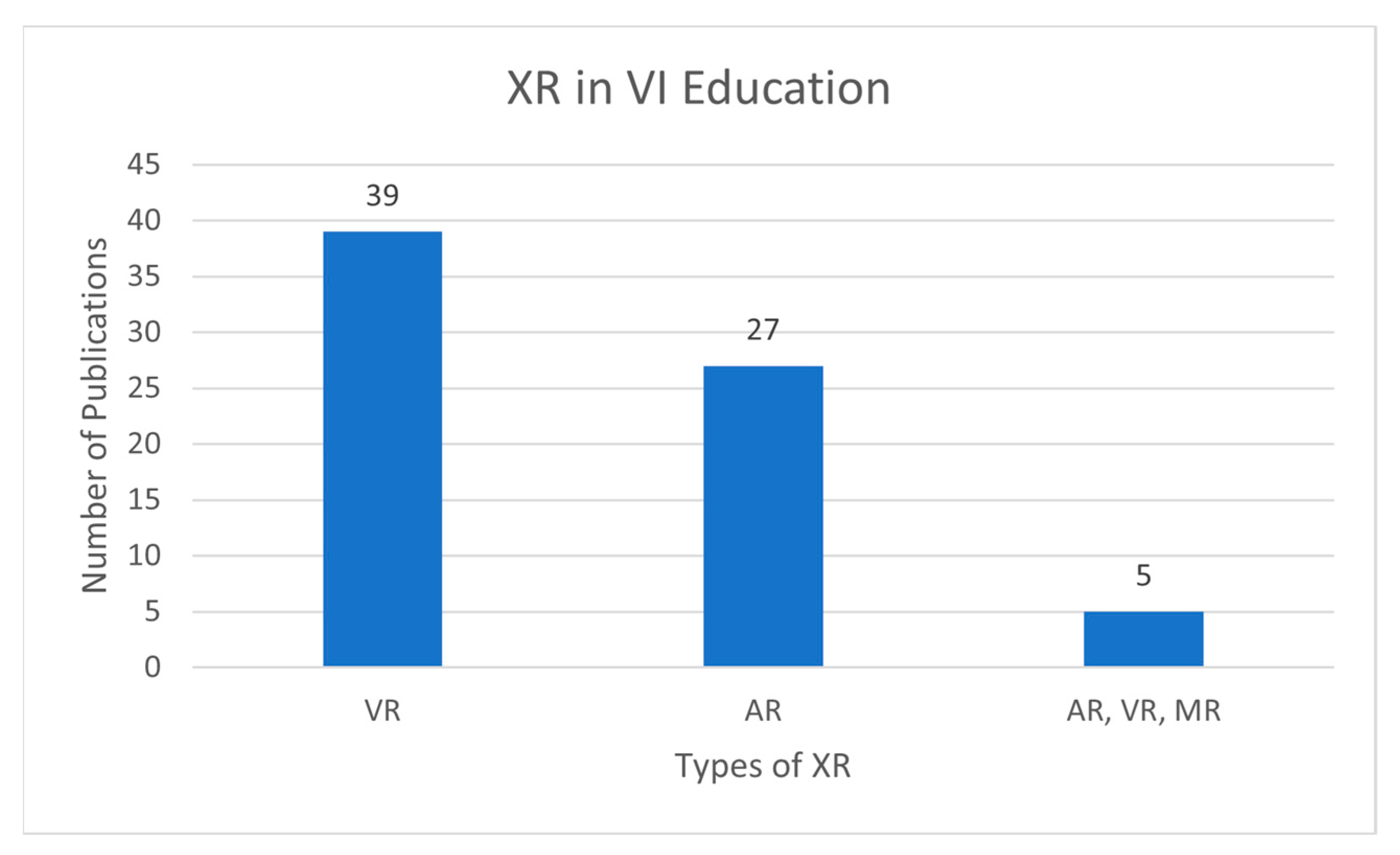
| Research Question | Themes | Subcategories |
|---|---|---|
| RQ01: What are the prevalent trends and themes surrounding the use of XR in the education of individuals who are blind or have visual impairments? | Educational Assistive Technology and Inclusive Education. | XR as an assistive tool |
| XR for museum accessibility | ||
| XR as assistant educational systems | ||
| Indoor and outdoor navigation systems | ||
| Enhancing various skills, promoting inclusion | ||
| Orientation and Mobility Education (O&M) | O&M training | |
| Interactive and cost-effective O&M | ||
| XR for white cane training | ||
| Multimodal cues for cognitive spatial maps | ||
| Spatial learning and navigation skills | ||
| Spatial Cognition | Sensory augmentation and substitution techniques | |
| Educational Games and Gamification | Sound design | |
| Inclusive gamming | ||
| Multimodal training | ||
| Audio games | ||
| Multisensory realities | ||
| Multisensory Realities and Sensory Substitution | Sensory Substitution Devices (SSDs) | |
| Audio–tactile content | ||
| Spatial representations with multimedia annotations | ||
| Authoring Tools for Educational Purposes | Teacher and student authoring | |
| The involvement of the target population and stakeholders in the design process | ||
| Academic Discipline | Mathematics | |
| Sport education | ||
| History | ||
| Chemistry | ||
| STEM | ||
| Geography | ||
| Physics | ||
| Music | ||
| Educational Maps | Mental representation skills | |
| Three-dimensional space | ||
| Spatialized Audio | Auditory orientation system | |
| Multi-User Extended Realities and Group Work | Multi-user Spatial XR | |
| Group work | ||
| Collaboration in multiplayer settings | ||
| Design Guidelines | Bespoke design | |
| Embedded inclusivity targeting VI | ||
| Gestures coupled with auditory feedback can bridge the sensory gap created by visual impairments | ||
| RQ02: What challenges and limitations exist in implementing XR in the education of VI students? | General Limitations | Small sample sizes |
| Repetition in this field of research | ||
| Incomplete reporting | ||
| Studies lack information on limitations | ||
| Specific challenges | ||
| RQ03: What recommendations can be made for future research on the use of XR in this field? | Designing for accessibility | |
| Assessment and research | ||
| Partnerships and collaboration among researchers, developers, educators, and individuals with visual impairments | ||
| VR game design | ||
| Personalise learning experiences | ||
| Develop reliable assessment tools | ||
| Haptic and audio technologies | ||
| Ethical considerations | ||
| Long-term impact of immersive technology on learning outcomes | ||
| explore the effectiveness of different types of XR, in meeting the diverse needs of VI students | ||
| The potential barriers to implementing XR for VI Education | ||
| Studying the cost-effectiveness and sustainability of integrating XR into VI education. |
Disclaimer/Publisher’s Note: The statements, opinions and data contained in all publications are solely those of the individual author(s) and contributor(s) and not of MDPI and/or the editor(s). MDPI and/or the editor(s) disclaim responsibility for any injury to people or property resulting from any ideas, methods, instructions or products referred to in the content. |
© 2024 by the authors. Licensee MDPI, Basel, Switzerland. This article is an open access article distributed under the terms and conditions of the Creative Commons Attribution (CC BY) license (https://creativecommons.org/licenses/by/4.0/).
Share and Cite
Hamash, M.; Ghreir, H.; Tiernan, P. Breaking through Barriers: A Systematic Review of Extended Reality in Education for the Visually Impaired. Educ. Sci. 2024, 14, 365. https://doi.org/10.3390/educsci14040365
Hamash M, Ghreir H, Tiernan P. Breaking through Barriers: A Systematic Review of Extended Reality in Education for the Visually Impaired. Education Sciences. 2024; 14(4):365. https://doi.org/10.3390/educsci14040365
Chicago/Turabian StyleHamash, Mahmoud, Hanan Ghreir, and Peter Tiernan. 2024. "Breaking through Barriers: A Systematic Review of Extended Reality in Education for the Visually Impaired" Education Sciences 14, no. 4: 365. https://doi.org/10.3390/educsci14040365
APA StyleHamash, M., Ghreir, H., & Tiernan, P. (2024). Breaking through Barriers: A Systematic Review of Extended Reality in Education for the Visually Impaired. Education Sciences, 14(4), 365. https://doi.org/10.3390/educsci14040365








